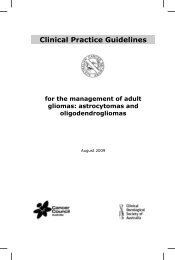Clinical Practice Guidelines for the management of locally advanced ...
Clinical Practice Guidelines for the management of locally advanced ...
Clinical Practice Guidelines for the management of locally advanced ...
Create successful ePaper yourself
Turn your PDF publications into a flip-book with our unique Google optimized e-Paper software.
Effectiveness The extent to which a specific intervention, when used under ordinary<br />
circumstances, does what it is intended to do.<br />
Ejaculate Fluid produced at ejaculation, which contains sperm and secretions from<br />
glands such as <strong>the</strong> prostate, seminal vesicles and testicles.<br />
Evaluation A <strong>for</strong>mal appraisal, using quantitative and/or qualitative data, <strong>of</strong> <strong>the</strong><br />
value <strong>of</strong> a project or program against a standard or set <strong>of</strong> specified<br />
criteria. An evaluation may be done internally or by an independent<br />
body. The purpose <strong>of</strong> <strong>the</strong> evaluation will determine whe<strong>the</strong>r it is<br />
designed to assess process, outcome or impact.<br />
Evidence Data on <strong>the</strong> effectiveness <strong>of</strong> a treatment or intervention derived from<br />
studies that compare it with an appropriate alternative. Preferably <strong>the</strong><br />
evidence is derived from a good-quality randomised controlled trial, but<br />
it may not be. In areas <strong>of</strong> medicine that do not involve a <strong>the</strong>rapeutic<br />
intervention, such as diagnosis, prognosis, aetiology and screening,<br />
evidence constitutes knowledge derived from properly conducted clinical<br />
or health services research.<br />
Evidence-based guideline A statement that is based on scientific literature, explicitly documents <strong>the</strong><br />
process used to develop <strong>the</strong> statement, and grades <strong>the</strong> strength <strong>of</strong> <strong>the</strong><br />
evidence used in making clinical recommendations.<br />
Five-year survival rate A scientific measure used to determine <strong>the</strong> success <strong>of</strong> a treatment. It<br />
measures <strong>the</strong> number <strong>of</strong> people who are alive five years after a particular<br />
treatment. It does not mean <strong>the</strong> patient will only live <strong>for</strong> five years after<br />
having treatment.<br />
General anaes<strong>the</strong>tic A drug given to stop a person feeling pain. A general anaes<strong>the</strong>tic causes<br />
temporary loss <strong>of</strong> consciousness.<br />
Gleason score A way <strong>of</strong> grading cancer cells. Low-grade cancers (Gleason score 2, 3, 4)<br />
are slower growing than high-grade (Gleason scores 8, 9, 10) cancers.<br />
The pathologist identifies <strong>the</strong> two most common tissue patterns and<br />
grades <strong>the</strong>m from 1 (least aggressive) to 5 (most aggressive). The<br />
Gleason score is given as two numbers added toge<strong>the</strong>r to give a score out<br />
<strong>of</strong> ten (<strong>for</strong> example, 3 + 4 = 7). The first number is <strong>the</strong> most common<br />
pattern seen under <strong>the</strong> microscope and <strong>the</strong> second number is <strong>the</strong> next<br />
most common.<br />
Grade A way <strong>of</strong> describing how abnormal <strong>the</strong> cancer cells look, and<br />
consequently how aggressive or fast-growing <strong>the</strong> cancer is likely to be.<br />
The most commonly used grading system is <strong>the</strong> Gleason score, which<br />
ranges from 2 to 10 (see above).<br />
Hazard ratio A measure <strong>of</strong> how <strong>of</strong>ten a particular event happens in one group<br />
compared to how <strong>of</strong>ten it happens in ano<strong>the</strong>r group, over time. In cancer<br />
research, hazard ratios are <strong>of</strong>ten used in clinical trials to measure survival<br />
at any particular moment in a group <strong>of</strong> patients who have been given a<br />
specific treatment or a placebo. A hazard ratio <strong>of</strong> one means that <strong>the</strong>re is<br />
no difference in survival between <strong>the</strong> two groups. A hazard ratio <strong>of</strong><br />
greater than one or less than one means that survival was better in one <strong>of</strong><br />
<strong>the</strong> groups.<br />
137<br />
Appendices



